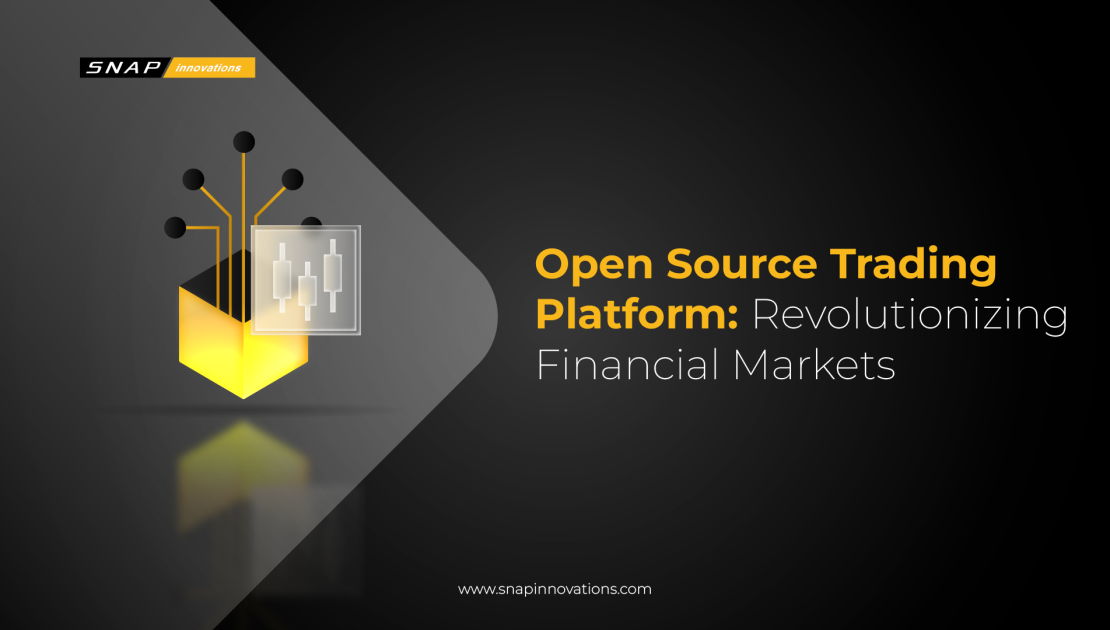In the ever-evolving landscape of financial markets, innovation is the key to success. Traders and institutions constantly seek tools and platforms that not only meet their needs but also provide flexibility, scalability, and transparency. Enter open source trading platforms – a game-changer that empowers financial markets like never before. In this article, we’ll delve into the world of open source trading platforms, exploring their definition, functionality, and the profound impact they have on the financial industry. From their inception to their future potential, we’ll uncover how these platforms are driving change and fostering a new era of trading.
What is an Open Source Trading Platform?
An open source trading platform, often abbreviated as OSTP, represents a paradigm shift in the world of financial markets. At its core, it’s a transformative concept that democratizes trading by providing unrestricted access to the source code of the trading software. This revolutionary approach empowers traders, institutions, and developers with unparalleled control, transparency, and adaptability. OSTPs break away from the traditional model of proprietary trading platforms, where the inner workings are concealed, and users have limited influence. In contrast, an OSTP invites collaboration, innovation, and customization by making its source code freely available for inspection, modification, and distribution.
The implications of this openness are profound. OSTPs embody the principles of transparency and trust, as users can scrutinize the code to ensure that it operates precisely as intended. This transparency eliminates the need to place blind trust in a black-box system, a common practice in proprietary platforms. Additionally, an OSTP is inherently flexible, allowing traders and institutions to tailor the platform to their unique strategies, preferences, and requirements. It’s a departure from the one-size-fits-all approach, where users must conform to the platform’s limitations. Instead, an OSTP adapts to the user’s needs, offering an agile and responsive trading experience.
Furthermore, the journey of an OSTP extends beyond its code; it’s a journey of community-driven development. An active and engaged community of developers, traders, and institutions collaborates to enhance and expand the platform’s capabilities continually. This collaborative spirit fuels innovation and ensures that the platform remains at the forefront of technological advancements. The evolution of an OSTP is not dictated by a single entity’s agenda; it’s a collective effort that reflects the diverse needs and aspirations of its user base. In essence, an OSTP is more than just a trading platform; it’s a catalyst for change, a symbol of empowerment, and a driver of progress in the ever-evolving world of financial markets.
The Evolution of Open Source Trading Platforms
 The evolution of open source trading platforms (OSTPs) represents a captivating journey through the annals of financial technology. It all began with a desire for transparency and control, a realization that the financial world needed a new approach. As OSTPs emerged, they disrupted the status quo of proprietary trading systems that held their source code in secret. With the source code made available to the public, the OSTP movement gained momentum, attracting pioneers who recognized the transformative potential of openness.
The evolution of open source trading platforms (OSTPs) represents a captivating journey through the annals of financial technology. It all began with a desire for transparency and control, a realization that the financial world needed a new approach. As OSTPs emerged, they disrupted the status quo of proprietary trading systems that held their source code in secret. With the source code made available to the public, the OSTP movement gained momentum, attracting pioneers who recognized the transformative potential of openness.
Also Read: Navigating the World of Execution Services: A Comprehensive Guide
Over time, OSTPs evolved to meet the increasing demands of the financial industry. What started as a quest for transparency and control grew into a global phenomenon. Today’s OSTPs offer a wealth of features and capabilities that rival even the most established proprietary platforms. They provide a versatile toolkit for traders and institutions, from algorithmic trading and risk management to connectivity with various markets and advanced data analysis. Institutions have seamlessly integrated OSTPs into their workflows, reducing costs and increasing efficiency.
Moreover, the open source community surrounding OSTPs has flourished. Developers from around the world collaborate to enhance these platforms continually. This collaborative ethos has given rise to a culture of innovation, where new ideas, improvements, and enhancements are shared openly. The result is a dynamic ecosystem that thrives on the collective expertise and dedication of its participants.
The Benefits of Open Source Trading Platforms
 The benefits of open source trading platforms are multifaceted, making them a compelling choice for traders and institutions alike. Let’s delve deeper into the extensive benefits of open source trading platforms
The benefits of open source trading platforms are multifaceted, making them a compelling choice for traders and institutions alike. Let’s delve deeper into the extensive benefits of open source trading platforms
1. Cost-Effectiveness
The cost-effectiveness of open source trading platforms extends beyond the immediate savings on licensing fees. It encompasses a broader financial perspective. Users can allocate their resources more strategically, channeling funds towards trading strategies, research, and risk management.
Additionally, the cost-effectiveness is evident in the long-term, as maintenance and support costs are often lower. The open source community offers a wealth of knowledge and troubleshooting resources, reducing the reliance on expensive vendor support contracts. This financial flexibility enables traders and institutions to optimize their operations and adapt to changing market conditions more effectively.
2. Scalability
Scalability is a fundamental advantage of open source platforms. These platforms are designed to accommodate the growing needs of institutions and traders. As trading volumes expand, and the scope of operations widens, open source platforms can effortlessly scale to meet these demands.
This scalability eliminates the need for costly and time-consuming platform migrations often associated with proprietary solutions. Institutions can focus on their growth strategies, secure in the knowledge that their trading platform can adapt seamlessly.
3. Customization
The high degree of customization offered by open source trading platforms empowers users to create tailored trading environments. This customization extends from user interface design to the development of algorithmic trading strategies.
Traders can implement proprietary indicators, risk management tools, and unique execution algorithms. This level of adaptability allows users to align their trading platform precisely with their strategies and preferences. It fosters a sense of ownership and control over the trading process, a feature not typically found in proprietary solutions.
4. Transparency
Transparency is a cornerstone of open source platforms. Users can inspect the source code to gain insights into how the platform operates. This transparency serves as a foundation of trust and accountability.
Traders and institutions can verify that the platform functions as intended, eliminating concerns about hidden vulnerabilities or undesirable behaviors. In the financial industry, where trust is paramount, this level of transparency is invaluable.
5. Community Support
The support ecosystem surrounding open source trading platforms is a vibrant and dynamic community of users, developers, and enthusiasts. Users have access to a wealth of resources, including forums, mailing lists, and collaborative projects. This community-driven support network offers assistance and solutions for a wide range of challenges. Experienced users readily share their knowledge and best practices, making it easier for newcomers to navigate the platform effectively. The sense of camaraderie and mutual support within this community is a testament to the collaborative spirit of open source.
6. Innovation
Innovation flourishes in the open source landscape. The collaborative nature of these platforms invites developers from around the world to contribute new features, enhancements, and plugins. This constant influx of fresh ideas and improvements keeps open source platforms at the forefront of technological advancements.
Users benefit from access to cutting-edge tools and capabilities, allowing them to adapt to market changes swiftly. The culture of innovation within the open source community is a driving force behind the continuous improvement and evolution of these platforms.
7. Integration
Open source trading platforms are designed with seamless integration in mind. They can connect effortlessly with various markets, exchanges, and data sources. This integration extends traders’ reach, enabling them to access a diverse range of assets and market information.
In today’s interconnected financial landscape, the ability to connect with multiple market sources is a strategic advantage. It enhances decision-making, trade execution, and risk management by providing a comprehensive view of market conditions.
These comprehensive benefits collectively make open source trading platforms an attractive choice for traders and institutions seeking efficiency, adaptability, and innovation in their trading endeavors. Beyond the practical advantages, these platforms embody a philosophy of empowerment, where users have control over their trading destiny and the tools to excel in the dynamic realm of financial markets.
Features of Open Source Trading Platforms
 Open source trading platforms come equipped with an array of features that cater to the diverse needs of traders and institutions. These features are designed to enhance trading efficiency, provide valuable insights, and streamline operations. Here are some key features commonly found in open source trading platforms:
Open source trading platforms come equipped with an array of features that cater to the diverse needs of traders and institutions. These features are designed to enhance trading efficiency, provide valuable insights, and streamline operations. Here are some key features commonly found in open source trading platforms:
1. Advanced Order Types
Open source trading platforms offer a rich array of advanced order types that cater to the diverse needs of traders. These include market orders, limit orders, stop orders, and more. Additionally, traders can leverage conditional orders, such as OCO (One-Cancels-the-Other) and OSO (One-Sends-the-Other), to automate complex trading strategies with precision.
Beyond standard order types, open source platforms often support custom order types. Traders can create specialized orders tailored to their strategies, incorporating specific conditions and execution parameters. This flexibility empowers traders to implement intricate trading strategies with ease.
2. Risk Management Tools
Effective risk management is a cornerstone of successful trading, and open source trading platforms offer a comprehensive suite of risk management tools. These tools encompass risk assessment, position sizing, and portfolio analysis. Traders can set predefined risk thresholds, enabling automated risk mitigation strategies. Real-time monitoring of risk exposure ensures traders can make informed decisions promptly.
Additionally, open source platforms often integrate margin and leverage management features. Users can customize margin requirements and leverage levels according to their risk tolerance and trading objectives. This granular control over risk management allows for a more precise and disciplined approach to trading.
3. Algorithmic Trading Support
Renowned for their support of algorithmic trading, open source trading platforms provide robust algorithm development environments, scripting languages, and APIs (Application Programming Interfaces) for creating and executing automated trading strategies. Traders can harness these capabilities to implement high-frequency trading algorithms, quantitative models, and statistical arbitrage strategies.
Moreover, open source platforms often offer backtesting tools that allow traders to evaluate the performance of their algorithms against historical data. This iterative process of development and testing is essential for refining and optimizing trading strategies.
4. Real-Time Data Analysis
Excelling in real-time data analysis and visualization, open source trading platforms provide access to a vast array of market data, including price quotes, order book depth, trade history, and news feeds. Traders can leverage this data to make informed decisions and gain insights into market dynamics.
Many of these platforms offer sophisticated charting tools with customizable technical indicators and overlays. These features empower traders to conduct in-depth technical analysis and identify potential trade opportunities. Real-time data analysis tools are invaluable for staying ahead in fast-paced markets.
5. Connectivity to Multiple Exchanges
Designed with connectivity to multiple exchanges and trading venues in mind, open source trading platforms offer APIs and connectivity protocols for accessing a wide range of markets, including equities, futures, options, and cryptocurrencies. This connectivity enables traders to diversify their trading portfolios and access diverse asset classes.
Additionally, open source platforms often support FIX (Financial Information eXchange) protocol, a standard for electronic trading communication. FIX connectivity simplifies order routing and execution across multiple exchanges, streamlining the trading process.
Also Read: Best Coding Languages for Trading Algorithms
6. Security Features
Security is a paramount concern in the financial industry. These platforms prioritize robust security features, implementing industry-standard encryption protocols to safeguard sensitive data and communications. Access controls and user authentication mechanisms ensure that only authorized personnel can access and manipulate trading systems.
Moreover, open source platforms often provide audit trails and compliance reporting tools, essential for regulatory compliance. These features help institutions maintain transparency and accountability in their trading operations.
7. Community-Driven Development
Benefiting from a vibrant and active community of developers, these platforms ensure that they remain up-to-date with the latest market trends and technology advancements. Users can access a continuous stream of updates, bug fixes, and enhancements, keeping their trading systems competitive.
The open source community also fosters collaboration and knowledge sharing. Users can engage in discussions, share code snippets, and contribute to the platform’s development. This collaborative environment promotes innovation and ensures that these platforms remain at the forefront of the industry.
These comprehensive features make open source trading platforms a compelling choice for traders and institutions seeking advanced tools and capabilities to thrive in the dynamic and competitive landscape of financial markets. From advanced order types to robust risk management and algorithmic trading support, these platforms empower users to execute sophisticated trading strategies with precision and confidence.
The Future of Open Source Trading Platforms
In the ever-evolving realm of financial markets, the future of open source trading platforms shines brightly with the promise of innovation and democratization. As technology continues to advance at a rapid pace, these platforms are poised to lead the way in providing traders and institutions with even more powerful tools and insights. The future holds the potential for enhanced machine learning and artificial intelligence integrations, enabling predictive analytics and adaptive trading algorithms.
Moreover, we can anticipate seamless cross-asset trading capabilities, allowing users to effortlessly navigate diverse markets from a single interface. Enhanced security measures will continue to be a priority, safeguarding the integrity of trading operations in an increasingly digital landscape. With a global community of developers driving progress, open source trading platforms are set to remain at the forefront of financial technology, empowering traders with the tools they need to navigate the complexities of modern markets effectively.
Conclusion
Open source trading platforms have emerged as a disruptive force in the financial industry, offering transparency, flexibility, and innovation. Whether you’re an individual trader seeking advanced tools or an institution looking to optimize your trading operations, these platforms provide a compelling solution.
As the financial world continues to evolve, open source trading platforms will play an increasingly vital role in shaping its future. With a community-driven approach to development and a commitment to empowerment, they are here to revolutionize the way we trade and invest. Embrace the power of open source and embark on a journey towards a more dynamic and transparent financial future.

